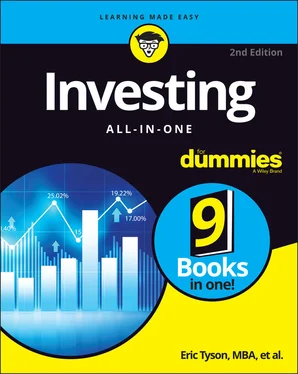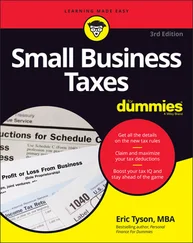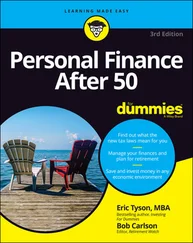Eric Tyson - Investing All-in-One For Dummies
Здесь есть возможность читать онлайн «Eric Tyson - Investing All-in-One For Dummies» — ознакомительный отрывок электронной книги совершенно бесплатно, а после прочтения отрывка купить полную версию. В некоторых случаях можно слушать аудио, скачать через торрент в формате fb2 и присутствует краткое содержание. Жанр: unrecognised, на английском языке. Описание произведения, (предисловие) а так же отзывы посетителей доступны на портале библиотеки ЛибКат.
- Название:Investing All-in-One For Dummies
- Автор:
- Жанр:
- Год:неизвестен
- ISBN:нет данных
- Рейтинг книги:3 / 5. Голосов: 1
-
Избранное:Добавить в избранное
- Отзывы:
-
Ваша оценка:
- 60
- 1
- 2
- 3
- 4
- 5
Investing All-in-One For Dummies: краткое содержание, описание и аннотация
Предлагаем к чтению аннотацию, описание, краткое содержание или предисловие (зависит от того, что написал сам автор книги «Investing All-in-One For Dummies»). Если вы не нашли необходимую информацию о книге — напишите в комментариях, мы постараемся отыскать её.
Investing All-in-One For Dummies
.
Dummies
Investing All-in-One For Dummies
Investing All-in-One For Dummies
Investing All-in-One For Dummies — читать онлайн ознакомительный отрывок
Ниже представлен текст книги, разбитый по страницам. Система сохранения места последней прочитанной страницы, позволяет с удобством читать онлайн бесплатно книгу «Investing All-in-One For Dummies», без необходимости каждый раз заново искать на чём Вы остановились. Поставьте закладку, и сможете в любой момент перейти на страницу, на которой закончили чтение.
Интервал:
Закладка:
Paying down your student loans depletes your emergency reserves. Psychologically, some people feel uncomfortable paying off debt more quickly if it diminishes their savings and investments. You probably don’t want to pay down your debt if doing so depletes your financial safety cushion. Make sure you have access — through a money market fund or other sources (a family member, for example) — to at least three months’ worth of living expenses (see the earlier section “ Establishing an emergency reserve”).
Considering paying down mortgage debt
Paying off your mortgage more quickly is an “investment” for your spare cash that may make sense for your financial situation. However, the wisdom of making this financial move isn’t as clear as is paying off high-interest consumer debt; mortgage interest rates are generally lower, and the interest is typically tax-deductible.
As with the decision to pay off a student loan faster (look to the previous section), when evaluating whether to pay down your mortgage quicker than necessary, compare your mortgage interest rate with your investments’ rates of return. Suppose you have a fixed-rate mortgage with an interest rate of 5 percent. If you decide to make investments instead of paying down your mortgage more quickly, your investments need to produce an average annual rate of return, before taxes, of more than 5 percent for you to come out ahead financially.
 Don’t get hung up on mortgage tax deductions. Although it’s true that mortgage interest is usually tax-deductible, you must also pay taxes on investment profits generated outside retirement accounts. You can purchase tax-free investments like municipal bonds, but over the long haul, such bonds and other types of lending investments (bank savings accounts, CDs, and other bonds) are unlikely to earn a rate of return that’s higher than the cost of your mortgage.
Don’t get hung up on mortgage tax deductions. Although it’s true that mortgage interest is usually tax-deductible, you must also pay taxes on investment profits generated outside retirement accounts. You can purchase tax-free investments like municipal bonds, but over the long haul, such bonds and other types of lending investments (bank savings accounts, CDs, and other bonds) are unlikely to earn a rate of return that’s higher than the cost of your mortgage.
Sorting Out Your Financial Plans
You should establish your financial goals before you begin investing. Otherwise, you won’t know how much to save or how much risk you need to take or are comfortable taking. You may want to invest money for several goals, or you may have just one purpose.
Considering your investment options and desires
Numerous good investing choices exist: You can invest in real estate, the stock market, mutual funds, exchange-traded funds, or your own business or someone else’s. Or you can pay down debts such as student loans, credit cards, an auto loan, or mortgage debt more quickly.
What makes the most sense for you depends on your goals as well as your personal preferences. If you detest risk-taking and volatile investments, paying down some debts, as recommended earlier in this chapter, may make better sense than investing in the stock market.
To determine your general investment desires, think about how you would deal with an investment that plunges 20 percent or 40 percent, over a short period of time. Some aggressive investments can fall fast. You shouldn’t go into the stock market, real estate, or small-business investment arena if such a drop is likely to cause you to sell or make you a miserable wreck. If you haven’t tried riskier investments yet, you may want to experiment a bit to see how you feel with your money invested in them.
 A simple way to mask the risk of volatile investments is to diversify your portfolio — that is, put your money into different investments. Not watching prices too closely helps, too; that’s one of the reasons why real estate investors are less likely to bail out when the market declines. Unfortunately, stock market investors can get minute-by-minute price updates. Add that fact to the quick click of your computer mouse or tap on your smartphone that it takes to dump a stock or fund in a flash, and you have all the ingredients for shortsighted investing — and potential financial disaster.
A simple way to mask the risk of volatile investments is to diversify your portfolio — that is, put your money into different investments. Not watching prices too closely helps, too; that’s one of the reasons why real estate investors are less likely to bail out when the market declines. Unfortunately, stock market investors can get minute-by-minute price updates. Add that fact to the quick click of your computer mouse or tap on your smartphone that it takes to dump a stock or fund in a flash, and you have all the ingredients for shortsighted investing — and potential financial disaster.
Making investing decisions and determining your likes and dislikes is challenging when you consider just your own concerns. When you have to also consider someone else, dealing with these issues becomes doubly hard, given the typically different money personalities and emotions that come into play. Usually one person takes primary responsibility for managing the household finances, including investments. The couples who do the best job with their investments are those who communicate well, plan ahead, and compromise.
 Couples stuck in unproductive patterns of behavior should get the issue out on the table. For these couples, the biggest step is making the time to discuss their financial management, whether as a couple or working with an advisor or counselor. The key to success is taking the time for each person to explain their different point of view and then offer compromises. So be sure to make time to discuss your points of view or hire a financial advisor or psychologist/marriage counselor to help you deal with these issues and differences.
Couples stuck in unproductive patterns of behavior should get the issue out on the table. For these couples, the biggest step is making the time to discuss their financial management, whether as a couple or working with an advisor or counselor. The key to success is taking the time for each person to explain their different point of view and then offer compromises. So be sure to make time to discuss your points of view or hire a financial advisor or psychologist/marriage counselor to help you deal with these issues and differences.
Assessing your savings rate
To accomplish your financial goals, you need to save money, and you also should know your savings rate. Your savings rate is the percentage of your past year’s income that you saved and didn’t spend.
Part of being a smart investor involves figuring out how much you need to save to reach your goals. Not knowing what you want to do a decade or more from now is perfectly normal; after all, your goals, wants, and needs evolve over the years. But that doesn’t mean you should just throw your hands in the air and not make an effort to see where you stand today and think about where you want to be in the future.
An important benefit of knowing your savings rate is that you can better assess how much risk you need to take to accomplish your goals. Seeing the amount that you need to save to achieve your dreams may encourage you to take more risk with your investments.
 During your working years, if you consistently save about 10 percent of your annual income, you’re probably saving enough to meet your goals (unless you want to retire at a relatively young age). On average, most people need about 75 percent of their preretirement income throughout retirement to maintain their standard of living.
During your working years, if you consistently save about 10 percent of your annual income, you’re probably saving enough to meet your goals (unless you want to retire at a relatively young age). On average, most people need about 75 percent of their preretirement income throughout retirement to maintain their standard of living.
If you’re one of the many people who don’t save enough, it’s time to do some homework. To save more, you need to reduce your spending, increase your income, or both. For most people, reducing spending is the more feasible way to save.
To reduce your spending, first figure out where your money goes. You may have some general idea, but to make changes, you need to have the data and facts. Examine your bill-paying records and review your credit card bills and any other documentation that shows your spending history. Tally up how much you spend on getting food out, operating your car(s), paying your taxes, and everything else. After you have this information, you can begin to prioritize and make the necessary trade-offs to reduce your spending and increase your savings rate. Earning more income may help boost your savings rate as well. Perhaps you can get a higher-paying job or increase the number of hours you work. But if you already work a lot, reining in your spending is usually better for your emotional and economic well-being.
Читать дальшеИнтервал:
Закладка:
Похожие книги на «Investing All-in-One For Dummies»
Представляем Вашему вниманию похожие книги на «Investing All-in-One For Dummies» списком для выбора. Мы отобрали схожую по названию и смыслу литературу в надежде предоставить читателям больше вариантов отыскать новые, интересные, ещё непрочитанные произведения.
Обсуждение, отзывы о книге «Investing All-in-One For Dummies» и просто собственные мнения читателей. Оставьте ваши комментарии, напишите, что Вы думаете о произведении, его смысле или главных героях. Укажите что конкретно понравилось, а что нет, и почему Вы так считаете.












